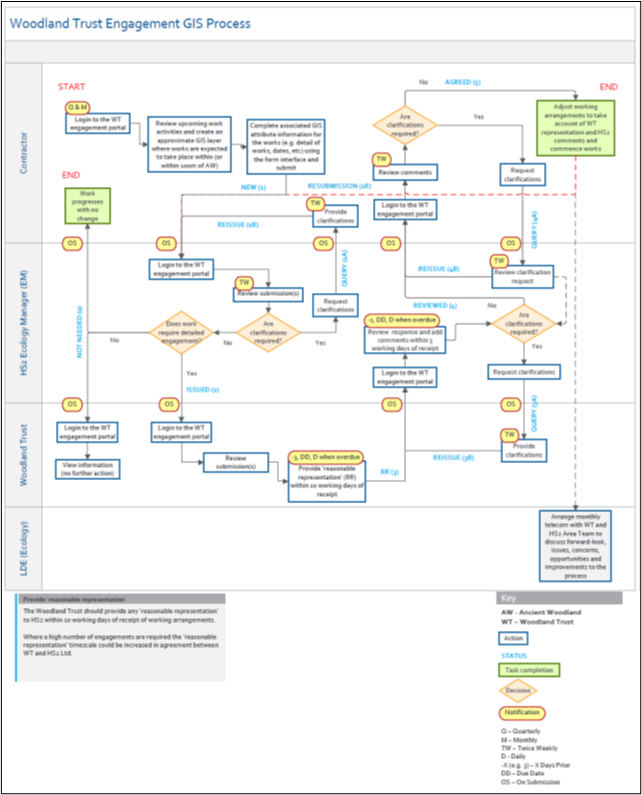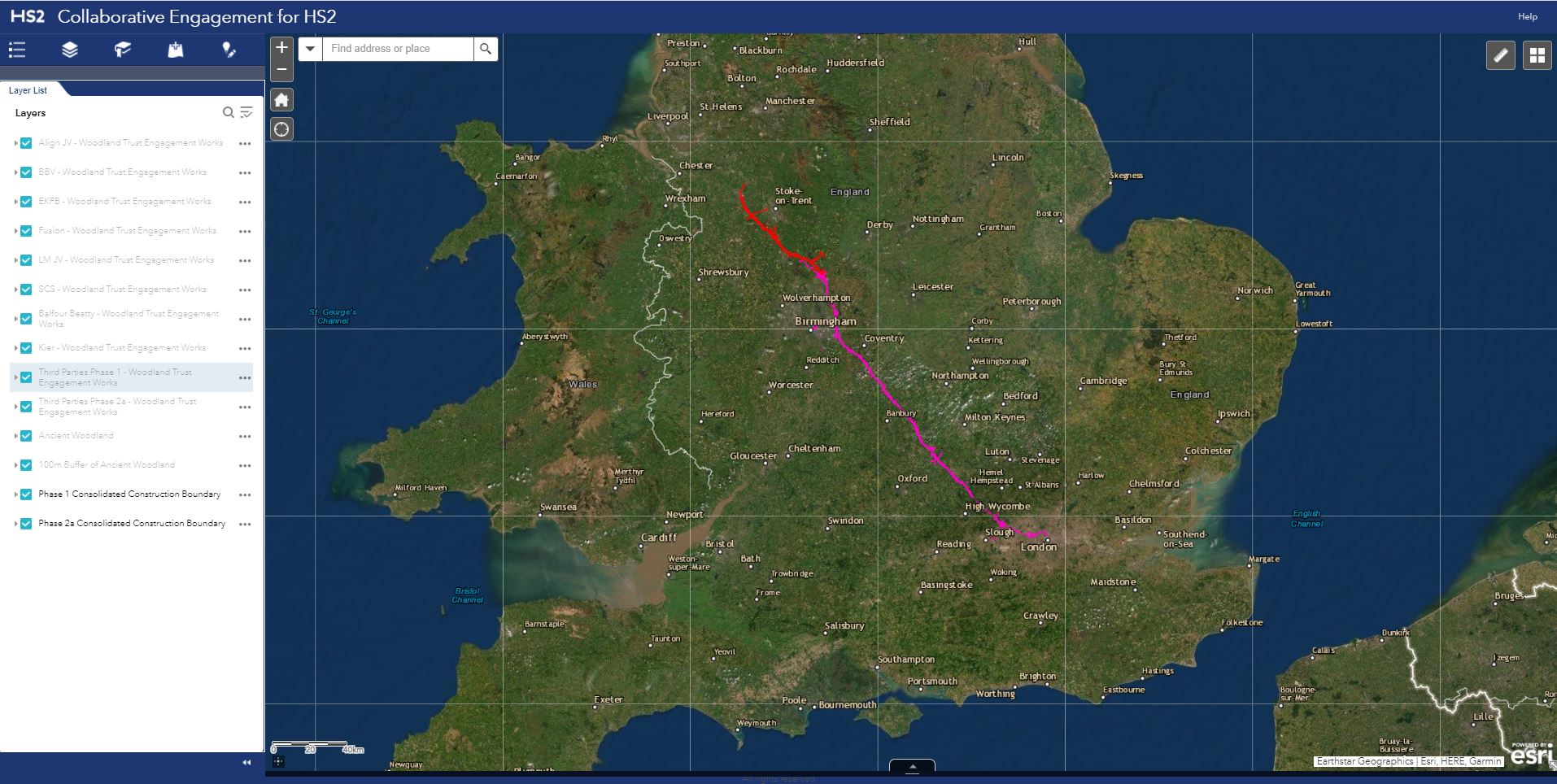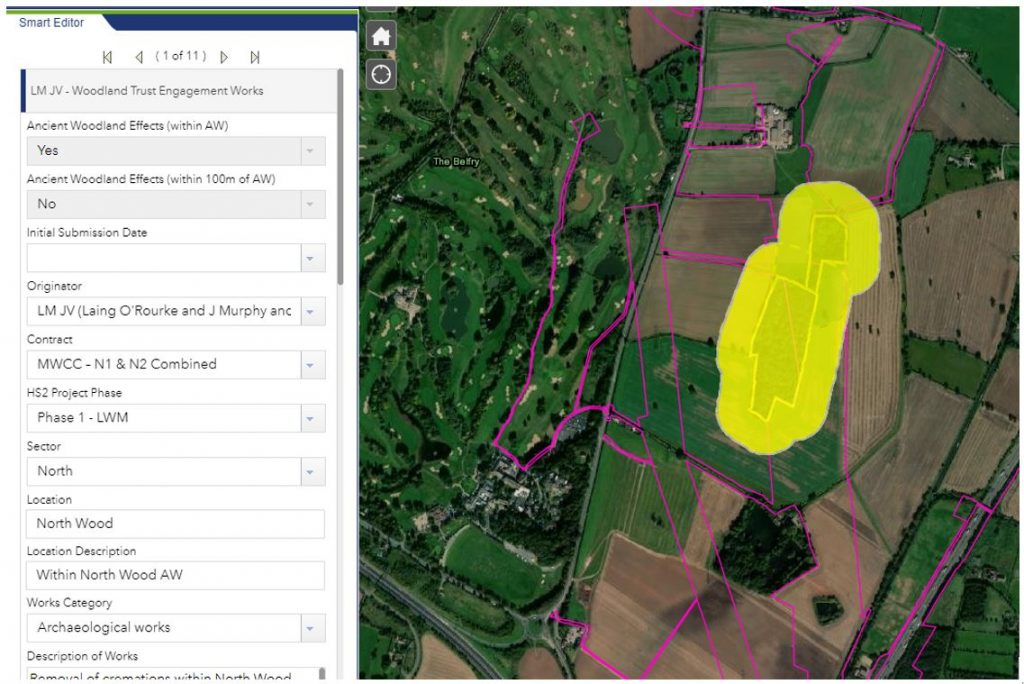HS2 Woodland Trust Engagement Portal – Enabling effective and efficient stakeholder engagement
Undertakings and Assurances (U&As) on Phase One of the High Speed Two (HS2) project requires HS2 to engage with the Woodland Trust for works within, or within 100m of, an ancient woodland.
HS2, in collaboration with contractors, third-party organisations and the Woodland Trust, have produced a web-based GIS portal for all contractors and third-party organisations to engage with the Woodland Trust. The tool is user-friendly, allows all information to be in one place, and has streamlined and automated the engagement process, saving time and reducing risks.
The portal has been welcomed by the Woodland Trust, ecology teams at HS2 and contractors alike and will be the standard means of communication with the Woodland Trust for Phase One and 2A and will be available for Phase 2B. The portal could be adapted for use with other key stakeholders on HS2, and by other projects.
Background
Undertakings and Assurances (U&As) on Phase One of the High Speed Two (HS2) project requires HS2 to engage with the Woodland Trust for works within, or within 100m of, an ancient woodland. To comply with the U&As HS2 developed an engagement process and agreed this with the Woodland Trust. This process relied heavily on the use of Excel spreadsheets and emails, required a lot of resource from parties (notably the ecology teams at HS2) to track engagements and follow up where need be, had no spatial element (GIS), and was not centralised and accessible to all. As works increased on Phase One, it became clear to all involved that a more effective and efficient approach was needed.
Approach
To enable ease of communications with the Woodland Trust and all information to be in one place, HS2 produced a web-based GIS portal for all contractors and third-party organisations to engage with the Woodland Trust where any works are taking place within, or within 100m of, an ancient woodland. Various approaches were considered, but it was felt that having a GIS-based interface would result in greater engagement, familiarity and traceability for people to find and archive information.
The tool (developed using the ESRI ArcGIS Enterprise Portal platform[1] and delivered to the end users via ArcGIS Enterprise Sites) removed the need for Excel spreadsheets and multiple emails and provides a centralised spatial dataset for all Woodland Trust engagements, thus maintaining a record of HS2 compliance with the U&As. Restricted access is given to named user accounts only. Each organisation can have two allocated users with editing rights to provide submissions (additional ‘viewer’ accounts can be provided as required).
The Workflow Diagram (Figure 1), which can be found in the Help/Guidance section of the portal, shows each step of the process and where responsibilities lie (see below image); this is built on the original processes agreed with the Woodland Trust to be fit for the system. The process is driven by the status field (shown in blue text on the diagram). When a new record is created or the status is changed, this creates automated email notifications for the appropriate people to move the record through the engagement process. If a record remains unchanged reminder emails are issued. Dashboards show the status of open engagements. All of this allows engagements to be closed out in a timely manner and not cause delays to programme critical work, and HS2 to meet their U&As.

There is a comprehensive and interactive Help/Guidance section on the portal (created using an ESRI StoryMap), which includes a full description of how to use the portal, a demonstration video and worked examples, so anyone who is new to the portal (either as an editor or viewer) can easily understand the process and get started.
During development of the portal, workshops and user-testing (involving test data) ensured it met the needs of all parties. Since the portal went live in March 2021, feedback from contractors, third-party organisations, the Woodland Trust and HS2 has continued to be captured to develop and improve the portal.
A challenge to overcome was determining which of the existing/historical engagements to include on the portal, as it was not going to be feasible to include everything from the past few years. It was necessary to agree criteria to apply and then add the information to the portal.
Outcome and learning
The portal (Figures 2 and 3) is user-friendly and has streamlined and automated the engagement process. Despite only having been up and running for nine months, it is performing successfully in terms of communication with a key stakeholder, making the submissions more consistent (by giving more concise structure, drop down menus, limited field length etc), reducing risk to the business from not meeting U&As (including reputational risk), reducing the risk of delays to programme critical work by the contractors and third-party organisations, and freeing up more of the technical team’s time.
Adjustments have been made to the portal based on feedback from the initial user-testing and subsequent use of the live portal by all parties. For example: the ability to attach documents to a record; contractors being able to see records from other Contractors but only able to edit their own records; making the dashboards available to the contractors as well as HS2; and inclusion of a resubmission workflow within the portal to allow for situations where completed engagements need to be revisited due to a change in circumstance.
The portal has been welcomed by the Woodland Trust, ecology teams at HS2 and contractors alike and will be the standard means of communication with the Woodland Trust for Phase One and 2A and will be available for Phase 2B. The portal could be adapted for use with other key stakeholders on HS2 in future, and similar systems implemented on other projects.


Recommendations
- Involve the key players who will need to use the system (in this case the contractors, third-party organisations, the Woodland Trust and HS2) from inception, through workshops and user testing, to capture their views and needs, and to continue taking onboard their feedback when the tool goes live
- Produce clear and comprehensive guidance and worked examples, which can be used to train new users and as a reference document/resource; and
- Future proof the tool so that it can accommodate additional users, activities and phases of work as easily as possible.
Conclusion
The original Excel spreadsheet and email-focussed process for engaging with the Woodland Trust on works within, or within 100m of, an ancient woodland was inefficient. The new web-based GIS portal is user-friendly and has streamlined and automated the engagement process, with multiple benefits including improving communication with a key stakeholder, making the submissions more consistent, reducing risk to the business from not meeting U&As, reducing the risk of delays to programme critical work by the contractors and third-party organisations, and freeing up more of the technical team’s time.
Recommendations include involving key players from the very start when developing similar tools, producing clear and comprehensive guidance and worked examples, and future proofing the tool as far as possible. The portal is being used by Phase One and 2A and will be available to Phase 2B. It could also be adapted for use with other key stakeholders on HS2 in future, and on other projects. In conclusion, the HS2 Woodland Trust Engagement Portal enables more effective and efficient stakeholder engagement.
Acknowledgements
The authors would like to thank everyone who contributed to the development of the portal, notably Russell Jordan, Steven Bosher and Ieuan Donovan in the EDP GIS team, and Harriet Webb formerly of the Phase 2A ecology team.
Footnote
This Learning Legacy paper is recognition of the production of a tool that has proved successful in solving a challenging engagement requirement for the Woodland Trust, HS2 Ltd, and its Contractors to monitor the loss of and impacts to ancient woodland.
References
[1] ESRI ArcGIS online portal . Accessed 8/12/21
Supporting materials
These resources are available (as onboarding tools for staff using the HS2 Woodland Trust Engagement Portal) and would be helpful for future projects and programmes to clearly demonstrate how the portal works and how it could benefit them.


